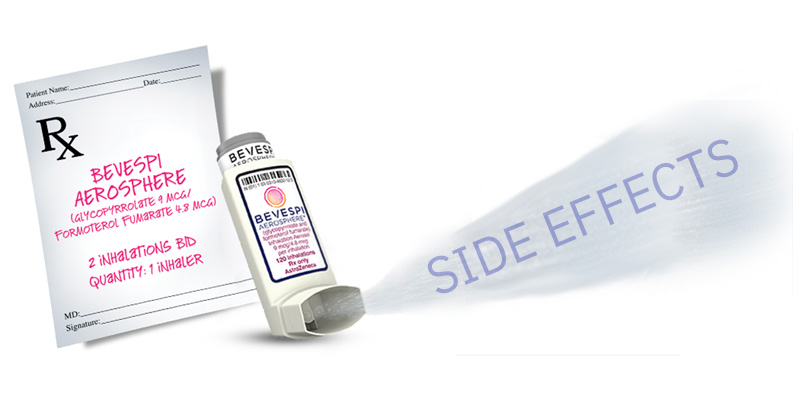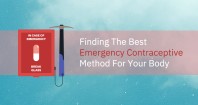
If you have COPD (chronic obstructive pulmonary disease), including emphysema and bronchitis, it’s likely that you’re on some type of inhaler or other medication to help you breathe better. If you’ve just been prescribed Bevespi Aerosphere or are interested in learning more about it, you’ve come to the right place. Bevespi Aerosphere is an inhalation aerosol that contains two main ingredients. The first is formoterol, which is a bronchodilator. The second is glycopyrrolate, an anticholinergic, and both work together to relax the muscles in the airways so that breathing is a lot easier.
All About Bevespi Aerosphere
Bevespi Aerosphere does two things: first, it prevents obstruction of airflow or bronchospasms. Second, it reduces the number of flare-ups you suffer so that you can be symptom-free for long periods of time. While Bevespi Aerosphere is not meant for people with asthma, it does well for people with COPD symptoms, and this is what it’s prescribed for the most. Keep in mind that Bevespi Aerosphere is not a rescue medicine; in other words, it does not work fast enough to treat a bronchospasm attack, which is one of the reasons it isn’t recommended for conditions such as asthma.
To understand the side effects of Bevespi Aerosphere, you should first know which conditions might prohibit you from taking this medication. The following conditions do not necessarily mean you should not take Bevespi Aerosphere, but they do mean you should mention them to your doctor before this medication is prescribed to you. These conditions include:
● Diabetes
● Liver disease
● High blood pressure
● Thyroid disorders
● Problems with urination
● Heart disease
● Glaucoma
● Allergies to food or drugs
● Seizures
Again, let your doctor know if you have any of these conditions or problems because only they will know for sure if you can safely take Bevespi Aerosphere. Naturally, you should also let your doctor know if you are pregnant or breastfeeding, and just know that Bevespi Aerosphere is not approved for anyone under the age of 18. If you have other medications, you’re on or any other medical conditions, always let the doctor know that as well. Your doctor needs to know your complete medical history before prescribing Bevespi Aerosphere.
Bevespi Aerosphere and Side Effects
When you’re taking Bevespi Aerosphere, you may or may not experience side effects. While some of these side effects are rare and some are more serious than others, it’s good for you to know what these side effects are so you can let your doctor know and let them decide if it’s a reason to be concerned. With Bevespi Aerosphere, there are side effects that are common and some that aren’t. To start with, let’s take a look at the side effects that should be taken seriously and immediately reported to your doctor. They include the following:
● Chest pain
● Bladder pain
● Urine that is cloudy or bloody
● Urination that is difficult or painful
● Fever
● Cough
● Chills
● Diarrhea
● Joint pain
● Loss of appetite
● Shivering
● Sore throat
● Urge to urinate frequently
● Tenderness or pain around the cheekbones or eyes
● Runny or stuffy nose
● Muscle aches or pains
● Pain in the lower back area or side
● Headache
● General feeling of pain or discomfort
● Nausea
● Vomiting
● Weakness or fatigue
● Sweating
● Tightening in the chest
● Trouble breathing
● Trouble sleeping
The main reason you’ll want to inform your doctor when you have any of these symptoms is that these are very serious symptoms, even though they are rare. Some other side effects that aren’t as uncommon but should still be taken seriously and reported to your doctor include:
● Reduced need to urinate (infrequent urination)
● Dry mouth
● Dizziness
● Blurred vision
● Agitation or irritation
● Difficulty passing urine (e.g., dribbling)
● Skin redness
● Restlessness or inability to relax
● Skin problems such as rashes, welts, etc.
● Breath odor that is fruity
● Heartbeat that is fast, pounding, irregular, etc.
● Increased thirst or hunger
● Fainting
● Flushed or dry skin
● Joints that are swollen or stiff
● Hoarseness
● Skin that turns red
● Tremors
● Difficulties swallowing
● Stomach pain
● Swelling in the hands, feet, or any area of the face
● Weight loss that is unexplained
Naturally, these side effects don’t necessarily have to be severe for you to contact your doctor. You know your body better than anyone does, so if you sense that you should call your doctor, then that is what you need to do. Never take a chance on your health, especially if this is the first time taking Bevespi Aerosphere. If you even think you should call your doctor, do so immediately.
That being said, there are also some side effects that are fairly common but are not a real concern. If you have the following symptoms when taking Bevespi Aerosphere, you do not need to report them to your doctor:
● Falls
● Anxiety
● Pain in your throat or mouth
● Pain in your arms or legs
● Bruising easily
● Toothache
● Difficulty moving
● Muscle stiffness or spasms
Of course, if you feel more comfortable calling your doctor so that the two of you can work together to decide if the symptom is a concern, by all means, go ahead and do so. Remember that it is always better to be safe than sorry. A good doctor will never mind you calling them and letting them know about symptoms that end up being no concern.
You should also keep in mind that these symptoms apply to all medications that consist of a combination of formoterol and glycopyrrolate, not just the specific medication called Bevespi Aerosphere. If the medication goes by another brand name but still contains these two ingredients, it may still produce these side effects and therefore you should let your doctor know about them.
Finally, realize that the symptoms listed above are not necessarily the only possible side effects of taking Bevespi Aerosphere, so if you have symptoms that are not on this list but you are concerned about them, always touch base with your doctor. Together, the two of you can decide if the symptoms are something to be concerned about and what you should do next.
How Should Bevespi Aerosphere Be Taken?
Now that we’ve gone over the side effects of Bevespi Aerosphere let’s talk more about the medication itself. It’s important to remember that taking the medication properly is crucial because sometimes, the way you feel when taking it is the result of taking it improperly, and are no actual side effects. Bevespi Aerosphere should be taken twice a day – once in the morning and once in the evening. Two inhalations is equal to one dose, so make sure you get one dose in the morning and another dose in the evening. Also, you’ll need to shake the dispenser well before you take the dosage each time so that it works right.
When you aren’t using the medication, always store it in a cool, dry place away from heat and extreme humidity. Keep it in the packaging until you are ready to use it, and after three months, you’ll need to throw away the package even if it is not completely empty. If the number on the device gets down to zero first, you should also throw it away. Most importantly, never stop using Bevespi Aerosphere abruptly because it can make your symptoms worse. Doctors usually prefer that you check with them before stopping the medication, and you should only do so with their approval and assistance.
One dose – two inhalations – of Bevespi Aerosphere contains 4.8 mcg of formoterol and 9 mcg of glycopyrrolate. If you happen to miss a dose, do not double up on the next dosage. Just take the dosage as you normally would if you hadn’t missed it. If you happen to overdose, call 911 immediately. Side effects that indicate an overdose include severe constipation, blurred vision, heart problems, fainting, chest pain, or vomiting. If you accidentally get the medication in your eyes, rinse them out very well with water, but call your doctor if your eyes remain red afterward.
Finally, you should never use Bevespi Aerosphere in addition to any other type of bronchodilator, especially if it contains ingredients such as arformoterol, salmeterol, indacaterol, vilanterol, or olodaterol. Always take the medication as prescribed by your doctor and read all of the enclosed literature. Taking Bevespi Aerosphere improperly can result in serious side effects and can be dangerous. And of course, if you have any questions or concerns about using Bevespi Aerosphere, always contact your doctor as soon as possible.
Conclusion
Bevespi Aerosphere is an inhalant medication devised for people with COPD. It is not for people with asthma and is not an emergency medication. While there seem to be a lot of possible side effects, keep in mind that most people do not suffer from any of the more serious ones. In fact, most people either only suffer mild side effects or none at all.
Nevertheless, you should never hesitate to contact your doctor if you have any side effects because only your doctor can determine how serious they are. Taking the medication properly is always recommended and can reduce the odds of suffering from those side effects.







